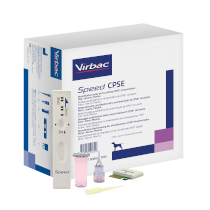
Immunofluorescence
Speed CPSE
Test for the quantitative dosage of circulating CPSE (Canine Prostatic Specific-Esterase) in male dogs.
Speed CPSE enables veterinarians to assess prostate health in unneutered male dogs, with quantitative results in just 10 minutes.
-
Speed CPSE enables veterinary surgeons to detect Benign Prostatic Hyperplasia (BPH) early in adult to mature unsterilised male dogs.
-
Speed CPSE makes it possible to monitor changes in prostate health over time in subjects at risk.
-
Thanks to Speed Reader technology, Speed CPSE provides a fully quantitative, accurate and validated assay using a reference method on a laboratory analyser.
For veterinary use only.
Product specifications
|
Sample type |
50 µL of serum or heparinate plasma |
|---|---|
|
Target species |
Male dog |
|
Handling time |
2 minutes |
|
Incubation |
/ |
|
Result |
10 minutes |
|
Operating range |
5 - 500 ng/mL |
|
Storage |
Store at the refrigerator between +2°C à +8°C until the expiry date indicated on the packaging |
|
Presentation |
Box of 6 tests |
Why measure CPSE ?
Benign prostatic hyperplasia (BPH) is one of the most common prostatic diseases in dogs.
It affects around 80% of unspayed male dogs over 5 years of age.
It is characterised by a progressive increase in the size of the prostate over time, and can be accompanied by complications (infection, prostatic cysts). Symptoms, such as blood in the urine, constipation or back pain, are usually delayed and common to other prostate disorders.
Such structural changes lead to an increase in blood levels of Canine Prostate-Specific Esterase (CPSE), a major seminal fluid protein secreted by the prostate gland in dogs.
CPSE is a specific marker of prostate secretion.
When to measure CPSE ?
Benign prostatic hyperplasia (BPH) can appear asymptomatically from the age of 3, and the risk increases with age, as do the onset of symptoms and the occurrence of complications. It affects around 80% of unspayed males over 5 years of age, making it the most common prostate disease in dogs.
Speed CPSE can be used for :
-
Early detection of BPH in non-castrated males, even in the absence of symptoms
-
Confirmation of suspected BPH in male dogs with compatible signs (urinary and micturition disorders, defecation problems, etc)
-
Regular monitoring of dogs with BPH in order to adapt treatment if the disease progresses.
Quick guide
Remove the tests, reagents and samples from the refrigerator 30 minutes before analysis so that the test material is at room temperature.
Start a ‘new test’ on the Speed Reader or from Speed Connect and follow the on-screen instructions.
For further details, please refer to the test instructions included in the Speed CPSE kits.
Recommendations
- Do not use EDTA or whole blood for the sample.
- Serum or heparinate plasma should be used at room temperature within one hour, and can be stored in a dry tube in a refrigerator for 24 hours, separated from the red blood cell pellet. After that, the sample should be frozen at -20°C.
- Bring cooled or freezed samples at room temperature before use (do not heat).
- Follow protocol steps and incubation times exactly.
- Follow the pipetting method indicated in the test instructions.
- Never mix reagents, test cassettes and calibration chips from one batch to another.
Speed CPSE performances
Validation of Speed CPSE versus ELISA (Enzyme-Linked ImmunoSorbent Assay) on plasma/serum samples :
| Unneutered male dogs (N=107) | |
|---|---|
| Linear regression | y=1,005x + 12.98 |
| Correlation | R2=0,97 |
Speed CPSE correlates well with the reference assay in male dogs.
References
Gobello, C. , Castex, G. , & Corrada, Y. (2002). Serum and seminal markers in the diagnosis of disorders of the genital tract of the dog: A mini‐review. Theriogenology, 57, 1285–1291. 10.1016/S0093-691X(02)00628-3
Melandri, Alonge; Highlights on the Canine Prostatic Specific Esterase (CPSE): A diagnostic and screening tool in veterinary andrology, Vet Med Sci. 2020;00:1–6.
Concentrations of canine prostate specific esterase, CPSE, at baseline are associated with the relative size of the prostate at three-year follow-up, BMC Vet Res. 2021; 17: 173.
Pinheiro, D. , Machado, J. , Viegas, C. , Baptista, C. , Bastos, E. , Magalhaes, J. , … Martins‐Bessa, A. (2017). Evaluation of biomarker canine‐prostate specific arginine esterase (CPSE) for the diagnosis of benign prostatic hyperplasia. BMC Veterinary Research, 13, 76 10.1186/s12917-017-0996-5
S.Alonge, 2017 EVSSAR Congress: Assessment of the threshold value of the CPSE to early detect dogs with ultrasonographic abnormalities
X. Lévy, P. Mimouni et al., 2017 EVSSAR Congress: Validation study of the in-clinic test Speed CPSE






